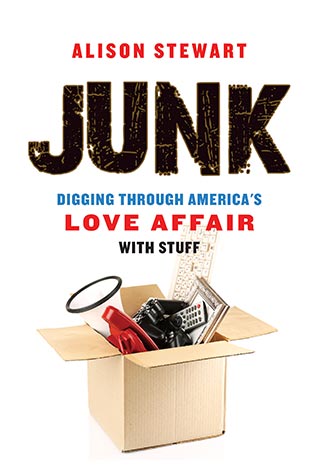Author Alison Stewart began the development of Junk: Digging Through America’s Love Affair with Stuff in a way that I love to approach book projects. Sparked by an experience in her life, she was left with questions she had a passion to answer. The book reflects her journey to find and share the answers. Her questions included:
Why do people hold on to junk?
Are we hardwired for it like some animals?
And how did removing junk, storing it, and organizing it become million-dollar industries?
And what qualifies as junk anyway?
From McMansions to Deserts
Stewart spent two years on the “junk research trail, from yard sales to McMansions to deserts,” and looks at junk from a kaleidoscope of angles, with breadth and depth. Well-written and creatively organized, the chapters flow from narrative to Q & A interviews and a mix of the two.
She gets readers’ feet wet with the junk world by joining her on the 250 mile “Highway 411 Yard Sale” which goes through Alabama, Georgia and Tennessee. As someone who loves to find treasures in trash, as they say, I have added this big sale to my bucket list. In her 411 trip and throughout the book, she teases out the many views of the differences between junk, stuff, and treasures.
Stewart gives interesting facts about junk history, such as the origins of the word “junk” itself, the history behind when formal “collecting” began (a long time ago), and famous collectors today and in history. Like it did for me, some of these collectors may surprise you.
From Pack Rats to Art

Cathedral of Junk
Stewart teaches us about extreme collecting through the lens of the “most well-known collectors of the animal kingdom.” Which animal? The pack rat. In her chapter on “Pack Rats (Human and Otherwise), we get to know the life of a pack rat (the animal) and see into the lives of (human) hoarders. She also goes into interesting psychology research on what experts have found regarding human “accumulation issues.”
Then there’s the world of junk art. Stewart interviews the eccentric Vince Hanneman, creator of the “Cathedral of Junk.” In learning about this junk art piece, like me, you’ll get why she describes his creation as “incredible, as in it is barely believable.”
The Big Business of Junk
Stewart gives us lots of stories from those who work in the junk removal business, and how they see people’s relationship to stuff first-hand. As the owner of Trash Daddy says, whether wealthy or poor, it can be sad to see how one’s life “can revolve around those material items.” In her interviews, some junk haulers also talk about the deeper meaning behind why people have to have a lot of stuff and have a hard time parting with it.
And who make great junk haulers? Veterans. Stewart takes us into the business, Junk Vets, run by vet Hector Caballero Jr. who is “a big fan of junk and the stories that come with it.” He too sees what’s behind people’s relationship to stuff and “loves the tales behind each item and its original owner.” Reading the experiences of junk removal experts really helps us see how the process can feel like “urban archeology.”
In addition to junk removal and hauling, readers go with Stewart into the world of the huge junk storage business. She discusses the rise and continued growth of these kind of businesses, such as The Container Store, and to the businesses that work along with them: Professional Organizers. These experts help us decide how much of our stuff should even go into storage containers in the first place.
From organizing and storing we go to how junk meets “show business.” Here Stewart does a “deep dive into subcultures surrounding junk, plus the colorful personalities attracted to it,” and how it has “become the engine for many, many cable television shows.” And public television shows – If you love antiques (as I do), you’ll especially enjoy the behind the scenes look at the Antiques Roadshow.
 Tiny, Reused & Recycled
Tiny, Reused & Recycled
Stewart has a chapter called, “All You Need is Less” where she takes us into tiny houses, and why they may be more than a passing fad. The result? Ultimately, less house, less stuff. Less stuff, less junk.
Arriving at less junk can mean finding new homes for it. This happens through groups like Freecycle, which connects people who want free items with owners who have the items and would like them to be reused or recycled. Other cool businesses Stewart discusses specialize in “upcycling,” which takes used items and creates new uses for them.
Space Junk
Learning about how much junk lives in space captivated and repelled me at the same time. Realizing the dangers of not removing it and the challenges of how to do so left me with new levels of concern about humans and trash. Stewart gives a particularly fascinating and disturbing interview with former NASA scientist Donald Kessler on why we need to clean up space.
Her last chapter ends on a junk love note. In her interview with Mary Randolph Carter, the author of Never Stop to Think…Do I have a Place for This?, we learn how a tragedy in Carter’s life influenced her relationship and love of stuff. Reading her story helps us see how for some people, junk can reflect “the evidence of life,” and how something that does not cost a lot can be utterly priceless.
In this informative and engrossing book, Stewart gets to the bottom of the questions she set out to answer and more. What a ride into the world of junk, and all it can mean, including what you keep and why in your own life.

